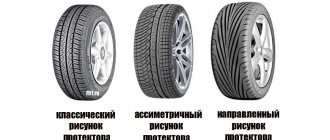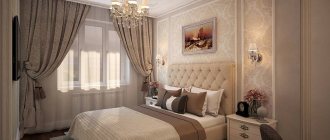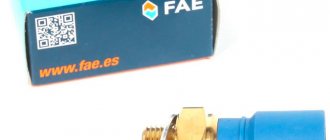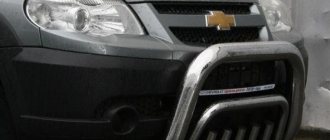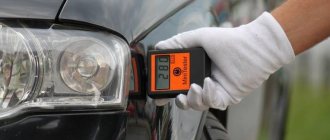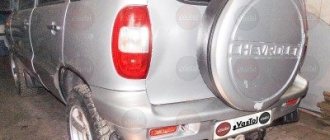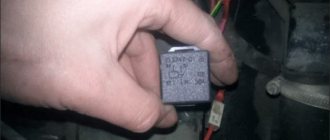Publication date: July 06, 2020. Category: Automotive equipment.
An additional luggage compartment located on the roof of a car such as the Niva Chevrolet is convenient for transporting large cargo that does not fit inside the car. If you have a trunk that is correct in terms of GOST, you can easily transport boards, furniture, skis, bicycles and much more. This product is also suitable for those who like to travel, because with it you can free up the necessary free space in the car interior.
However, before you start studying the drawing of an expeditionary trunk for a Chevrolet Niva, it’s worth talking about all the nuances of this car accessory.
Advantages and disadvantages of an expeditioner
There are two types of racks designed for Niva: closed box or expeditionary. The latter belongs to the power type due to the following characteristics:
- large capacity (up to 200 kg);
- possibility of installing additional headlights and other elements.
It is also worth noting the appearance of the security officer, which looks much more harmonious on an SUV than the box, which is more suitable for passenger cars.
Almost any fastener can be installed on the expedition vehicle, making it possible to transport any type of cargo.
However, such an accessory also has a number of disadvantages, namely:
- the expeditionary trunk worsens the aerodynamics of the car;
- the cargo will be open, which is not very convenient when transporting things that should not get wet or dirty;
By and large, all these problems can be solved. For example, the aerodynamic characteristics of the luggage compartment can be improved through an improved design, and the cargo itself can be covered with polyethylene. In addition, Niva owners rarely care about aerodynamics, since for trips to the countryside or on a hike, a speed of 90 km/h will be enough (at this speed the trunk will not affect handling).
Increased noise effects are often attributed to the shortcomings of security forces, but these accusations are not justified, since with high-quality hermetic welding and plugging of the ends there cannot be such a problem.
And if we talk about the cost, then the security officer will cost the same as boxing - about 15,000 rubles. However, the latter is clearly inferior to the expeditionary option in many respects. In addition, making a box yourself will be much more difficult than making an expedition rack with your own hands, the drawings of which will be presented below.
So, where to start creating an expedition ship? First of all, you need to decide on the material and make the necessary calculations.
Key Features and Benefits
Let's assume that you decide to install a spacious expedition trunk on your Chevy Niva. This is a large platform with sides into which all sorts of things are loaded. It differs from a regular trunk in its reinforced design, which allows you to count on impressive loads.
An expedition trunk (EB) can be described as a basket with a frame structure and additionally several supports. They allow you to install mounts on the roof, that is, on the roof rails of your SUV. Installation of such a design will provide you with the opportunity to transport large cargo that does not fit in your domestic Niva or Chevrolet Niva, or free space is required for passengers.
I would include the following advantages and key features of EB:
- versatility and multifunctionality;
- structural strength with simultaneous lightness;
- a way to get rid of excess cargo inside the car;
- attractive appearance.
Yes, the simplest solution would be to buy a ready-made factory expedition rack. Check out your options. But such ready-made designs are not the cheapest, so not every one of you will want or be able to buy them.
Sometimes car owners, in order not to spend extra money, decide to make an electric vehicle for their Niva on their own. A good option, since a homemade trunk is not much different from a factory one. Only for this purpose use high-quality materials and take a responsible approach to assembling the structure. I will try to help you with this.
Selecting the material from which the trunk will be made
When choosing the main material for an expedition trunk, car enthusiasts often cannot decide between aluminum and steel. Both of these metals have their own pros and cons, so before you start making a security device, it is important to know that:
- Aluminum and its alloys are lightweight, which saves fuel. In addition, this material is flexible and has high tear resistance. However, aluminum will not withstand heavy loads, which is why it will not be possible to transport heavy loads in such a trunk.
- The weight of steel is much higher than its aluminum counterpart. Among the advantages of this material, it is worth noting the strength of the structure (even in a situation where the car rolls over, such a security force will be able to protect the roof from severe damage). In addition, aluminum racks are assembled with bolts, and steel ones are welded, so you don’t have to worry that the rack will simply fall apart due to shaking or vibration.
Calculations and preparation
When creating an expedition trunk for the field with your own hands, you need to study the drawings carefully and compare them with the dimensions of your car. Niva models are different, so take the time to measure the roof and decide on the supports.
To create a drawing of the future trunk, you need to clarify the following data:
- dimensional parameters;
- approximate frame weight;
- luggage capacity;
- estimated weight of the entire homemade external luggage compartment.
As a result, you should have a drawing approximately like this.
You also need to prepare:
- welding machine;
- grinder;
- pipes with a diameter of 20x20 mm, with a square cross-section;
- fasteners.
After you have double-checked all the measurements, you can move on from theory to practice.
see also
Comments 35
Today I will pick up the new fastening strips from the warehouse, exactly according to the drawing. If it's not a secret, why is it on the bar: 55 center-to-axle? And 3 holes exactly at 12? It is important ?
I made this hole there in place. There was no car nearby, so I didn’t notice the error.
Today I will pick up the new fastening strips from the warehouse, exactly according to the drawing. If it's not a secret, why is it on the bar: 55 center-to-axle? And 3 holes exactly at 12? It is important ?
Regarding the 3 holes: the top hole, yes, should be 12, a 10 bolt goes in there. And the two lower holes are to reduce weight. They don't play any piano. You don't have to do them at all.
Read more: Hi gear for power steering reviews
I asked the boys to do: 56 on the bar and 3 of 10 because. I will assemble everything with M8 bolts. I changed the design of the trunk a little - when I’m finished I’ll post a photo with explanations. And thank you very much.
For the benefit of! Then send me a link to what happened!
With some changes I’m making myself a trunk for the field: drawing of the strip and brackets - center line for bolts 85 and 56... It didn’t work out. I will re-drill the bar. Thank you very much for the rest.
Yes, it's a jamb! I'll look at it at my leisure. Thank you.
Did you redo the drawing?
No. There's simply no time.
Did you redo the drawing?
I looked at it in more detail. I thought about redoing the drawing. It turns out that everything is correct there. According to the rules, when reading the drawing you need to pay attention to the fact that the size is placed ABOVE THE ARROWS, then everything will “grow together”.
With some changes I’m making myself a trunk for the field: drawing of the strip and brackets - center line for bolts 85 and 56... It didn’t work out. I will re-drill the bar. Thank you very much for the rest.
Actually, the size is written at the top of the line and everything is correct there. 55 and 56
Yes, I noticed this yesterday. I'm sorry . The boys did it at the vocational school - they made a mistake. And I already measured it when it was ready.
Actually, the size is written at the top of the line and everything is correct there. 55 and 56
Yes, it’s better to make it 56mm in the BRACKET, it’s easier to mark, and in the PLAN it’s in place.
With some changes I’m making myself a trunk for the field: drawing of the strip and brackets - center line for bolts 85 and 56... It didn’t work out. I will re-drill the bar. Thank you very much for the rest.
I looked at it in more detail. I thought about redoing the drawing. It turns out that everything is correct there. According to the rules, when reading the drawing you need to pay attention to the fact that the size is placed ABOVE THE ARROWS, then everything will “grow together”. And one more thing: make holes with a diameter of 8 mm in the MOUNTING PLAN (center distance 55 mm) IN PLACE! What is this connected with: You will make holes in the MOUNTING BRACKET about 8 mm with an interaxial distance of 55 mm (it would be better to make 56 mm to make marking more convenient). IN THE MOUNTING BRACKET (it is placed outside the entire structure) it is necessary to make beautiful and even holes “according to the drawing” for aesthetics. And make the corresponding holes in the MOUNTING PLAN in place, because they are not visible, and no one knows what kind of seal you will use. I'm talking about the gasket between the drain and the MOUNTING PLAN. I made it from door seal 2112, and someone will put a piece of thin rubber. Hence the depth of placement of the PLANK in the drain, and you will make fastenings in place during fitting; it won’t take long.
We make a supporting frame
Based on the previously created drawing, make racks that need to be welded in the shape of a rectangle. Attach ponds along the inner perimeter of the frame. To prevent deflection when loading the trunk, it is recommended to add additional stiffeners made of profile metal (2-3 pieces), which will be located at equal distances in the resulting free plane.
In order to further strengthen the structure, cut small pieces from the profile pipe. They must be cut so that square-shaped cells are formed inside.
After this, you can move on to the next stage of work - ensuring aerodynamics and fixing the sides of the trunk.
We improve aerodynamic qualities
To do this, it is necessary to weld a trapezoidal structure (a kind of arc) to the front part of the security device. The size of its base will be equal to the width of the welded trunk body, and it is recommended to make an overlap along the edges of 5 cm. The smaller part of the finished trapezoid can be arbitrary, and the angle of inclination should be 35-40 degrees.
At the bend points, it is necessary to cut out triangular sectors with a grinder, so that a jumper 5-7 mm long remains to the end of the profile. After this, the structure must be heated and bent so that a trapezoid emerges.
After this, the resulting structure is welded to the platform. To strengthen the frame, you can install 2-3 removable jumpers on the trapezoid side. To secure the sides, you need to make holes into which special bushings of the required diameter will be inserted. Weld them in such a way that the frame does not begin to bend when the bolts are tightened.
Next, we make the sides themselves. To do this, you need to cut 8 racks about 6.5 cm long.
To secure the studs:
- drill 2 holes 8 cm each;
- insert pins into them;
- weld the parts;
- cut off the required amount of thread from it;
- screw the studs into the resulting holes.
Next you need to construct the side upper crossbar. Bend the resulting part at the front in the same way as the front frame. A paired element is made using the same principle. To secure the front top rail, weld a bushing to the bend of the side rail. But a piece of stud is welded onto the front beam. The rear crossbar is arranged in exactly the same way.
DIY expedition trunk for more space in the cabin
In specialized stores you will find a bunch of different models of car roof racks. Yes, you will be glad. You're happy until you see the price tag. Another thing is a do-it-yourself expeditionary trunk. However, you need to think about several issues regarding the shape and weight of the cargo you are going to transport.
We present to you the main contender for applause - aluminum. Aluminum sheets are lightweight and difficult to bend or puncture.
More often than not, owners of domestic cars want to do this kind of work with their own hands. Let's take, for example, a roof rack for a Niva or UAZ. A suitable material for the structure would be a thin-walled profile pipe. In other cases, ferrous metal or stainless steel, as well as many others, are possible.
As an example, let’s take a trunk being manufactured from a metal profile.
We measure the length and width of the roof. We need to find out the weight of the future structure, taking into account the material and measured parameters. How to do it? Microsoft Excel is here to help you. The weight of the structure will be shown immediately after recording all the characteristics.
We will weld the perimeter of the future trunk, and at an equal distance inside the perimeter we will weld two jumpers that will “hold” the structure. Railings will be installed to these jumpers, and the platform will be connected to the railings. After the main jumpers, we will begin installing intermediate ones, for greater strength. This brings the assembly of the supporting frame to an end.
Next, the profile pipe comes into play. It will serve as a connecting element between all jumpers. For aesthetics and aerodynamics of the trunk, an arch is installed in the front part of the structure. In the places where it bends there should be a sector, and at the edge there should be an overlap of 5 cm. We weld the arc to the front part of the surface, and also add jumpers.
What is an expeditionary trunk without sides? It is advisable to make removable sides in order to change them as needed. The sides will be attached to holes that need to be welded and plugged with bushings. This will prevent the profile from deforming when tightening the bolts.
Now about how to make the sides themselves. We will need 8 racks, each about 6.5 cm long. The fastening pin can only be welded between two holes, which is what we will do. After drilling two holes, we will weld the stud.
Have you forgotten how we bent the front arch? We also bend the side upper crossbar. One, another. Next, we weld the bushing to the bend point of the crossbar on the side so that the upper part of the front crossbar is securely fastened.
Now all the work is almost done. The hour has come for creative motorists. We need to paint the entire structure and give it a little style. To avoid rust, we recommend applying a coat of primer and only then thinking about paint. Among soil solutions, the most resistant to salt influences is soil containing zinc.
After applying a layer of primer, you should wait at least a day, and then use regular enamel and apply the desired color to the trunk. Many people don’t like the way the bolts look at the joints of the structure. To avoid an unsightly appearance, you can place decorative nuts in these places. Here's a modern trunk for you.
The main function of a roof rack is to save space inside. By installing additional equipment, you can expand its functionality.
- “Fog lights” are lights that will illuminate the road even better.
- There is space for a hijack and a shovel in the inner and outer sides. Oh, how the gardeners will be happy.
- If you often drive through overgrown areas, such as forests, you can install branch guards. They will protect the glass from damage.
Don’t forget also that the expedition vehicle protects the roof itself well from dents. As you can see, such a trunk can serve as a good tool not only for saving space, but also for protecting the body and for installing useful equipment. In addition, in addition to the racks themselves, other structures can be attached to the roof rails for transporting fishing or hunting equipment.
As you can see, it’s possible to make a trunk with your own hands. Larger Mitsubishi L200s will require a side ladder. For small foreign cars, a reinforced frame will be sufficient.
Advantages and disadvantages
Advantages of an expedition rack:
- large load capacity (up to 200 kg);
- large margin of safety;
- when driving through forest areas it is not damaged, but the box, made of plastic, is scratched and broken;
- Various elements can be attached to the arches, for example, a spare wheel holder, additional headlights.
Disadvantages of an expedition trunk:
- worsens the aerodynamic qualities of the car;
- does not provide protection for cargo from wind, precipitation, or impacts from branches;
- worsens the appearance of the Niva.
Many car enthusiasts do not pay attention to the noted shortcomings or eliminate them:
- An SUV is not a racing car, and air resistance begins to manifest itself significantly at speeds over 90 km/h. To reduce drag, fairings can be installed on the arches.
- Car enthusiasts install branch guards on their own, come up with protection for the load and its fastening.
- Successful tuning of the trunk, done by yourself, gives the car a unique, and sometimes even exotic look.


